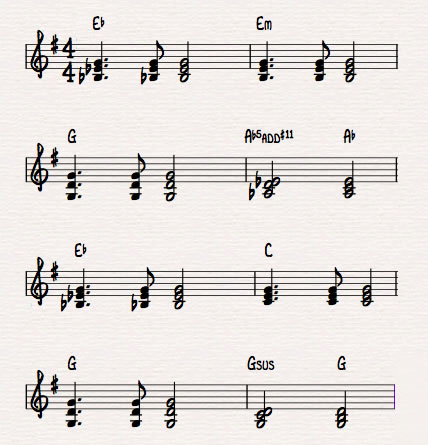I’ve been working on a lot of music lately. Sometimes, ideas and concepts come from unusual places. This time, it came from software.
I was trying out Sibelius, an excellent music notation program. I usually don’t go about writing music in a transcription app, but I was dragging notes around on the staff when ideas came to me, so I went with it.
The first is a type of chord movement I’ve been toying with for some time now. It involves taking one note from a chord, and using it to “pivot” to just about ANY other chord. I’m not sure what the actual terminology for this is, but the sound is unmistakable. Below is an example:

The Eb and Em share the note G. In Eb, it’s the major 3rd, and in Em, it’s a minor third. The effect is especially strong with these to chords – perhaps because the roots and fifths in the chords each move one half step with each other in perfect parallel, breaking longstanding rules of classical voice leading. But as I see it, a rule are more like a strong suggestion in music. There is always a time and place to break it.
The second example is a little less jarring:

This is because, while the Eb and C still have a G in common, there is no parallel motion. Eb moves a half step to E natural while the Bb moves a whole step up to C. It’s a smoother sound.
The second idea is what I have now learned to be a “Secondary Subdominant.” If your not familiar with the terminology, here’s some background.
(Begin long explaination…)
In a major “chord scale” – or a sequence of chords within major a key – the I is the tonic, the ii is the Supertonic, iii is the Mediant, IV is the Subdominant, V is the Dominant, vi is the Submediant, and vii is the Leading Tone. These terms are just names for the function of the chord within the key. Of them, leading tones and dominants have the strongest functionality in that they always seem to possess a pull back to the tonic.
“Secondary” is a bit more complicated. It refers to when a chord is used that is not in the key, but it is used to lead to another chord, usually one that is in the key. I might use A7 in a song in C. A7 is not in C, but it is in the key of Dm, and Dm IS in C. A7 is the dominant of the key of Dm, making it a secondary dominant for C. Get it?
“Secondary dominants” are quite common. They are used as transitional a progression and are quite useful for connecting otherwise unrelated chords.
(…end long explanation.)
I got to thinking… Why just use dominants as a secondary? Sure, V-I is the ever-popular Classical Cadence, used in everything from Mozart to punk rock. But the IV-I is quite strong too. It’s the “Amen” at the end of every hymn. Why not a “secondary subdominant” movement? Could that be cool?
It IS!!
Below is an example of how I used a sec. subdom. (Ab) to transition between two seemingly unrelated keys (G and Eb.)

I particularly like how I mad the 5th of the G chord (D) carry over into the Ab as a #11. This does two things. First, it creates yet another “pivot”-type transition between the G and Ab. Very smooth for such an unconventional switch. Secondly, it reinforces the Ab’s subdominant sound, since #11 only occurs as an upper extension of the VI within a major key.
So, with all that said, here’s the progression I wrote. It employs both techniques mentioned above. I used it as a refrain for a song I’m writing, which is tentatively being called “Plight of the Elitist.” I will upload an audio example as soon as I get it recorded. Enjoy!
